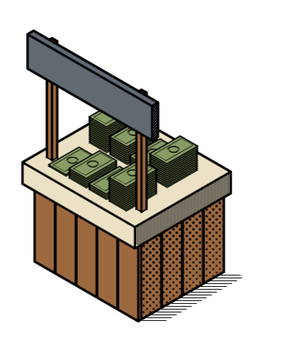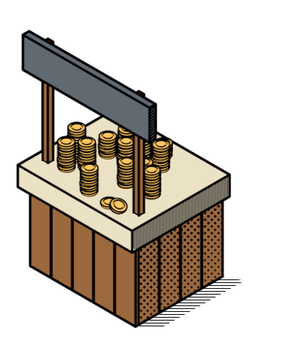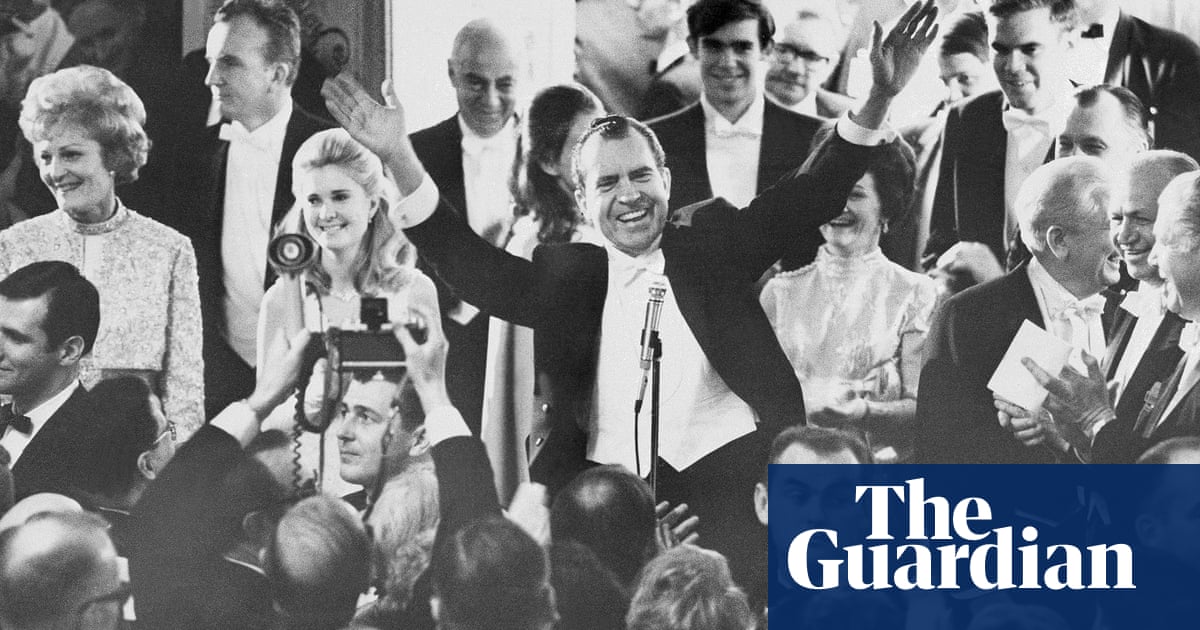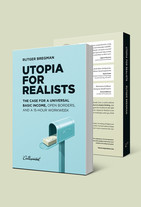The bizarre tale of President Nixon and his basic income bill
It was the summer of ’69, the end of the decade that brought us flower power and Woodstock, rock ’n’ roll and Vietnam, Martin Luther King and a feminist revolution. It was a time when everything seemed possible, even a conservative president strengthening the welfare state.
Richard Nixon was not the most likely candidate to pursue the old utopian dream, but then history sometimes has a strange sense of humor. The same man who was forced to resign after the Watergate scandal in 1974 had been on the verge, in 1969, of enacting an unconditional income for all poor families. It would have been a massive step forward in the War on Poverty, guaranteeing a family of four $1,600 a year, equivalent to roughly $10,000 in 2016.
First, however, some trial runs were needed. Tens of millions of dollars were budgeted to provide a basic income for more than 8,500 Americans in New Jersey, Pennsylvania, Iowa, North Carolina, Indiana, Seattle, and Denver in what were also the first-ever large-scale social experiments to distinguish experimental and control groups. The researchers wanted answers to three questions:
- Would people work significantly less if they receive a guaranteed income?
- Would the program be too expensive?
- Would it prove politically unfeasible?
The answers? No, no, and maybe.
Reductions in working hours were limited across the board. “The ‘laziness’ contention is just not supported by our findings,” the chief data analyst of the Denver experiment said. “There is not anywhere near the mass defection the prophets of doom predicted.” The decline in paid work averaged 9% per family, and in every state it was mostly twentysomethings and women with young children who worked less.
Later research showed that even 9% was probably exaggerated. In the original study, this was calculated on the basis of self-reported income, but when the data was compared with official government records, it turned out that a significant portion of earnings had gone unreported. After correcting for this discrepancy, the researchers discovered that the number of hours worked had scarcely decreased at all.
The "declines in hours of paid work were undoubtedly compensated in part by other useful activities, such as search for better jobs or work in the home,” noted the Seattle experiment’s concluding report. For example, one mother who had dropped out of high school worked less in order to earn a degree in psychology and get a job as a researcher. Another woman took acting classes; her husband began composing music. “We’re now self-sufficient, income-earning artists,” she told the researchers. Among youth included in the experiment, almost all the hours not spent on paid work went into more education. Among the New Jersey subjects, the rate of high school graduations rose 30%.
Richard Nixon was not the most likely candidate to pursue the old utopian dream, but then history sometimes has a strange sense of humor.
And thus, in the revolutionary year of 1968, when young demonstrators the world over were taking to the streets, five famous economists – John Kenneth Galbraith, Harold Watts, James Tobin, Paul Samuelson, and Robert Lampman – wrote an open letter to Congress. “The country will not have met its responsibility until everyone in the nation is assured an income no less than the officially recognized definition of poverty,” they said in an article published on the front page of The New York Times. According to the economists, the costs would be “substantial, but well within the nation’s economic and fiscal capacity.”
The letter was signed by 1,200 fellow economists.
One man began to realize where all this was heading – to a future where money was considered a basic right. Martin Anderson was an advisor to the president and was vehemently opposed to the plan. A great admirer of the philosopher Ayn Rand, whose utopia revolved around the free market, the concept of a basic income ran counter to everything Anderson believed in: the smallest possible government and maximum individual responsibility.
So he launched an offensive.
The Shadow of Speenhamland
On the same day that Nixon intended to go public with his plan, Anderson handed him a briefing. Over the weeks that followed, this six-page document, a case report about something that had happened in England 150 years before, did the unthinkable: It completely changed Nixon’s mind, and in the process, changed the course of history.
The report was titled “A Short History of a ‘Family Security System’” and consisted almost entirely of excerpts from sociologist Karl Polanyi’s classic book The Great Transformation (1944). In the seventh chapter, Polanyi describes one of the world’s first welfare systems, known as the Speenhamland system, in early 19th-century England. This system bore a suspiciously close resemblance to a basic income.
Polanyi’s judgment of the system was devastating. Not only did it incite the poor to even greater idleness, damping their productivity and wages, it threatened the very foundations of capitalism. “It introduced no less a social and economic innovation than the ‘right to live,’” Polanyi wrote, “and until abolished in 1834, it effectively prevented the establishment of a competitive labor market.” In the end, Speenhamland resulted in “the pauperization of the masses,” who, according to Polanyi, “almost lost their human shape.” A basic income introduced not a floor, he contended, but a ceiling.
At the top of the briefing presented to Nixon was a quotation by the Spanish-American writer George Santayana: “Those who cannot remember the past are condemned to repeat it.”
The president was stunned. He called on his key advisors and ordered them to get to the bottom of what had transpired in England a century and a half earlier. They showed him the initial findings of the pilot programs in Seattle and Denver, where people clearly had not started working less. Furthermore, they pointed out, Speenhamland more resembled the social spending mess that Nixon had inherited, which actually kept people trapped in a vicious poverty cycle.
Poverty simply meant you were strapped for cash. Nothing more, nothing less.
Two of Nixon’s leading advisors, the sociologist and later Senator Daniel Moynihan and the economist Milton Friedman, argued that the right to an income already existed, even if it was “a legal entitlement that society has nevertheless managed to stigmatize.” According to Friedman, poverty simply meant you were strapped for cash. Nothing more, nothing less.
Yet Speenhamland cast a shadow that extended far beyond the summer of 1969. The president changed tack and settled on a new rhetoric. Where his basic income plan had initially made almost no provision to compel people to work, he now began stressing the importance of gainful employment. And whereas the basic income debate under President Johnson had begun when experts signaled unemployment as becoming endemic, Nixon now spoke of joblessness as a “choice.” He deplored the rise of big government, even though his plan would distribute cash assistance to some 13 million more Americans (90% of them working poor).
“Nixon was proposing a new kind of social provision to the American public,” writes the historian Brian Steensland, “but he did not offer them a new conceptual framework through which to understand it.” Indeed, Nixon steeped his progressive ideas in conservative rhetoric.
What, we may well ask, was the president doing?
There is a brief anecdote that explains it. On August 7 of that same year, Nixon told Moynihan that he’d been reading biographies of the British Prime Minister Benjamin Disraeli and the statesman Lord Randolph Churchill (the father of Winston). “Tory men and liberal policies,” Nixon remarked , “are what have changed the world.” The president wanted to make history. He saw himself presented with the rare, historic chance to cast out the old system, raise up millions of working poor, and win a decisive victory in the War on Poverty. In short, Nixon saw basic income as the ultimate marriage of conservative and progressive politics.
All he had to do was convince the House and Senate. To put his fellow Republicans at ease and manage concerns over the Speenhamland precedent, Nixon decided to attach an additional proviso to his bill. Basic income beneficiaries without a job would have to register with the Department of Labor. Nobody in the White House expected this stipulation would have much effect. “I don’t care a damn about the work requirement,” Nixon said behind closed doors. “This is the price of getting $1,600.”
The next day, the president presented his bill in a televised speech. If “welfare” had to be packaged as “workfare” to get basic income through Congress, then so be it. What Nixon failed to foresee was that his rhetoric of fighting laziness among the poor and unemployed would ultimately turn the country against basic income and the welfare state as a whole. The conservative president who dreamed of going down in history as a progressive leader forfeited a unique opportunity to overthrow a stereotype rooted back in 19th-century England: the myth of the lazy poor.
To dispel this stereotype, we have to ask a simple historical question: What was the real deal with Speenhamland?

Illustrations by Michiel van den Berg for The Correspondent
The Irony of History
Rewind to the year 1795.
The French Revolution had been sending shock waves across the European continent for six years. In England, too, social discontent had reached a boiling point. Only two years earlier a young general by the name of Napoleon Bonaparte had crushed the English at the Siege of Toulon in southern France. If that weren’t bad enough, the country was suffering another year of bad harvests with no hope of importing grain from the continent. As grain prices continued to rise, the threat of revolution loomed ever closer to British shores.
In one district in southern England, people realized that repression and propaganda would no longer suffice to stem the tide of discontent. On May 6, 1795, the magistrates of Speenhamland gathered at the village inn in Speen and agreed to radically reform assistance for the poor. Specifically, the earnings of “all poor and industrious men and their families” would be supplemented up to the subsistence level, at a rate fixed to the price of bread and paid out per family member. The larger the family, the greater the payments.

This was not the first-ever program of public relief, or even the first in England. During the reign of Queen Elizabeth I (1533-1603), the Poor Law had introduced two forms of assistance – one for the deserving poor (the elderly, children, and disabled) and another for those who had to be forced to work. Those in the first category were placed in almshouses. Those in the second were auctioned off to landowners, with the local government supplementing their wages up to an agreed minimum. The Speenhamland system put an end to this distinction, just as Nixon would aspire to do 150 years later. From then on, needy was just plain needy, and everybody in need had a right to relief.
The system quickly caught on across the south of England. To all appearances, it was a great success: Hunger and hardship decreased and, more importantly, revolt was nipped in the bud. In the same period, however, some were raising doubts about the wisdom of aiding the poor. In his 1786 Dissertation on the Poor Law, the vicar Joseph Townsend had already, almost a decade before Speenhamland, warned that “it is only hunger which can spur and goad them on to labour; yet our laws have said, they shall never hunger.” Another clergyman, Thomas Malthus, elaborated on Townsend’s ideas. In the summer of 1798, on the eve of the Industrial Revolution, he described “the great difficulty” on the road to progress, “that to me appears insurmountable.” His premise was twofold:
- Humans need food to survive, and
- The passion between the sexes is ineradicable.
His conclusion? Population growth will always exceed food production. According to the pious Malthus, sexual abstinence was the only thing that could prevent the Four Horsemen of the Apocalypse from descending to spread war, famine, disease, and death. Indeed, Malthus was convinced that England was teetering on the brink of a disaster as terrible as the Black Death that wiped out half the population between 1349 and 1353.
In any case, the consequences of assistance for the poor were sure to be dire. The Speenhamland system would only encourage people to marry and procreate as fast and as prolifically as possible. One of Malthus’ close friends, the economist David Ricardo, believed a basic income would also tempt them to work less, causing food production to fall even further and as yet fan the flames of a French-style revolution on English soil.

In the late summer of 1830, the predicted uprising broke out. Shouting “Bread or Blood!” thousands of agricultural laborers up and down the country wrecked landowners’ harvesting machines and demanded a living wage. The authorities cracked down hard, arresting, incarcerating, and deporting 2,000 rioters and sentencing others to death.
In London, government officials realized something had to be done. A national inquiry was launched into agricultural working conditions, rural poverty, and the Speenhamland system itself. The largest government survey to date was undertaken in the spring of 1832, with investigators conducting hundreds of interviews and collecting reams of data that were ultimately compiled in a 13,000-page report. But the bottom line could be summed up in a single sentence: Speenhamland had been a disaster.
The investigators behind this Royal Commission survey blamed the basic income for a population explosion, wage reductions, increased immoral conduct... effectively, for the utter deterioration of the English working class. Fortunately, though, no sooner had the basic income been repealed, they wrote , than:
- The poor once more became industrious.
- They developed “frugal habits.”
- “Demand for their labour” increased.
- Their wages “in general advanced.”
- They entered into fewer “improvident and wretched marriages.”
- Their “moral and social condition in every way improved.”
Widely circulated and endorsed, the Royal Commission Report was long considered an authoritative source in the emerging social sciences, marking the first time a government had systematically gathered data as input for a complicated decision.
Even Karl Marx used it as the basis for his condemnation of the Speenhamland system in his magnum opus Das Kapital 30 years later, in 1867. Poor relief, he said, was a tactic employers used to keep wages as low as possible by putting the onus on local government. Like his friend Friedrich Engels, Marx saw the old poor laws as a relic of a feudal past. Releasing the proletariat from the shackles of poverty required a revolution, not a basic income.
Critics of Speenhamland had acquired towering authority, with everyone from left to right relegating it to history’s failures. Far into the 20th century, eminent thinkers such as Jeremy Bentham, Alexis de Tocqueville, John Stuart Mill, Friedrich Hayek, and, above all, Karl Polanyi would denounce it. Speenhamland was the textbook example of a government program that had, with the best of intentions, paved the road to hell.
150 Years Later
But that wasn’t quite the whole story.
In the 1960s and 1970s, historians took another look at the Royal Commission Report on Speenhamland and discovered that much of the text had been written before any data was even collected. Of the questionnaires distributed, only 10% were ever filled out. Furthermore, the questions were leading, with the answer choices all fixed in advance. And almost none of the people interviewed were actual beneficiaries. The evidence, such as it was, came mostly from the local elite, and especially the clergy, whose general view was that the poor were only growing more wicked and lazy.
The Royal Commission Report, largely fabricated, supplied the underpinnings of a new, draconian Poor Law. It was even said that the Commission’s secretary, Edwin Chadwick, had “the Bill in his head” before the investigation even started, but he was shrewd enough to obtain some substantiating evidence first. Chadwick was furthermore blessed with the “admirable faculty” of getting eyewitnesses to say what he wanted, just like “a French cook who can make an excellent ragout out of a pair of shoes,” according to a fellow Commission member.
The U.S. experiments had been groundbreaking and meticulous, but had almost no influence at all; while the Speenhamland report, based on bogus science, managed to redirect the President’s course of action 150 years later.
The investigators barely concerned themselves with analyzing the data, though they did employ “an elaborate structure of appendixes to lend more weight to their ‘findings,’” two modern-day researchers note. Their approach could not have been more different than that of the rigorous experiments conducted in the U.S. in the 1960s and 1970s. Those experiments had been groundbreaking and meticulous but had almost no influence at all, whereas the Royal Commission Report was based on bogus science yet still managed to redirect President Nixon’s course of action 150 years later.
More recent research has revealed that the Speenhamland system was actually a success. Malthus was wrong about the population explosion, which was attributable chiefly to growing demand for child labor. At the time, children were like walking piggy banks, their earnings a kind of pension plan for parents. Even now, as soon as populations escape poverty, birth rates drop and people find other ways to invest in their future.
Ricardo’s analysis was equally faulty. There was no poverty trap in the Speenhamland system and wage earners were permitted to keep their allowance – at least in part – even if their earnings increased. As such, basic income didn’t cause poverty, but was adopted in precisely those districts where suffering was already the most acute. And the rural unrest had actually been triggered by the 1819 decision to return to the prewar gold standard on the advice, incidentally, of David Ricardo.
Marx and Engels were also misguided. With all the competition among landowners to attract decent labor, wages couldn’t simply be lowered. On top of this, modern historical research has revealed that the Speenhamland system was more limited than assumed. Villages where the system had not been implemented suffered the same hardships attending the gold standard, the advent of Northern industry, and the invention of the threshing machine. Threshers, which literally helped separate the wheat from the chaff, destroyed thousands of jobs in one fell swoop, thereby depressing wages and inflating the cost of poor relief.
All the while, the steady upward trend of agricultural production never faltered, increasing by a third between 1790 and 1830. Food was more plentiful than ever, yet a decreasing share of the English population could afford it. Not because they were lazy, but because they were losing the race against the machine.
A Heinous System
In 1834, the Speenhamland system was permanently dismantled. The 1830 uprising, which probably would have happened earlier if not for the basic income, sealed the fate of the first cash transfer trial, with the poor blamed for their own poverty.
The new Poor Law introduced perhaps the most heinous form of “public assistance” that the world has ever witnessed. Believing workhouses to be the only effective remedy against sloth and depravity, the Royal Commission forced the poor into senseless slave labor, from breaking stones to walking on treadmills. And all the while, the poor went hungry. In the town of Andover, inmates even resorted to gnawing on the bones they were supposed to grind up for fertilizer.
On entering the workhouse, spouses were separated and children taken away from their parents, never to be seen again. Women were starved as a precaution against pregnancy. Charles Dickens achieved fame with his portrayal of the plight of the poor at this time. “Please, sir, I want some more,” asks little Oliver Twist in a poorhouse where the boys get three daily helpings of gruel, two onions a week, and a sliver of bread on Sundays. Far from helping the poor, it was this specter of the workhouse that enabled employers to keep wages so miserably low.
Meanwhile, the myth of Speenhamland played a pivotal role in propagating the idea of a free, self-regulating market. According to two contemporary historians, it helped to “cover up the first major policy failure of the new science of political economy.” Not until after the Great Depression did it become clear just how shortsighted Ricardo’s obsession with the gold standard had been. Ultimately, the perfect, self-regulating market proved an illusion.
The Speenhamland system, by contrast, was an effective means of addressing poverty. In a world that was changing at a breakneck pace, it offered security. “Far from having an inhibitory effect, it probably contributed to economic expansion,” concluded a later study. Simon Szreter, a historian at Cambridge University, even argues that anti-poverty legislation was instrumental in England’s rise as a world superpower. According to Szreter, by boosting workers’ income security and mobility, the old Poor Law and the Speenhamland system made the English agricultural industry the most efficient in the world.

Illustrations by Michiel van den Berg for The Correspondent
A Pernicious Myth
And yet, almost 150 years later, history was about to repeat itself.
According to Nixon, this generation would do two things deemed impossible by earlier generations. Besides putting a man on the moon (which had happened the month before), they would also, finally, eradicate poverty.
A White House poll found 90% of all newspapers enthusiastically receptive to the plan to pay an unconditional income to all poor families. The Chicago Sun-Times called it “A Giant Leap Forward,” the Los Angeles Times “a bold new blueprint.” The National Council of Churches was in favor, and so were the labor unions and even the corporate sector. At the White House, a telegram arrived declaring, “Two upper middle class Republicans who will pay for the program say bravo.” Pundits were even going around quoting Victor Hugo – “Nothing is stronger than an idea whose time has come.”
It seemed that the time for a basic income had well and truly arrived.
“Welfare Plan Passes House [...] a Battle Won in Crusade for Reform,” headlined The New York Times on April 16, 1970. With 243 votes for and 155 against, President Nixon’s Family Assistance Plan (FAP) was approved by an overwhelming majority. Most pundits expected the plan to pass the Senate, too, with a membership even more progressive than that of the House of Representatives. But in the Senate Finance Committee, doubts reared. “This bill represents the most extensive, expensive, and expansive welfare legislation ever handled,” one Republican senator said. Most vehemently opposed, however, were the Democrats. They felt the FAP didn’t go far enough, and pushed for an even higher basic income. After months of being batted back and forth between the Senate and the White House, the bill was finally canned.



In the following year, Nixon presented a slightly tweaked proposal to Congress. Once again, the bill was accepted by the House, now as part of a larger package of reforms. This time, 288 voted in favor, 132 against. In his 1971 State of the Union address, Nixon considered his plan to “place a floor under the income of every family with children in America” the most important item of legislation on his agenda.
But once again, the bill foundered in the Senate.
And then the myth of Speenhamland returned in full force. As the 1970s drew to a close, conservative thinkers began lambasting the welfare state, using the very same arguments applied back in 1834.
These arguments echoed in Wealth and Poverty, the 1981 mega-bestseller by George Gilder that would make him Reagan’s most cited author and which characterized poverty as a moral problem rooted in laziness and vice. And they appeared again a few years later in Losing Ground, an influential book in which the conservative sociologist Charles Murray recycled the Speenhamland myth. Government support, he wrote, would only undermine the sexual morals and work ethic of the poor.
It was like Townsend and Malthus all over again. Even former Nixon advisor Daniel Moynihan stopped believing in basic income, following a fatal discovery upon publication of the final results of the Seattle experiment. One finding in particular grabbed everybody’s attention: The number of divorces had jumped more than 50%. Interest in this statistic quickly overshadowed all the other outcomes, such as better school performance and improvements in health. A basic income, evidently, gave women too much independence.
Ten years later, a reanalysis of the data revealed that a statistical error had been made; in reality, there had been no change in the divorce rate at all.
Ayn Rand’s faithful follower Martin Anderson smelled victory. “Radical welfare reform is an impossible dream,” he crowed in The New York Times. The time had come to ax the old welfare state, like the English Poor Law before it in 1834. In 1996 the Democratic President Bill Clinton finally pulled the plug on “the welfare state as we know it.” For the first time since the passage of the Social Security Act in 1935, assistance for the poor was again seen as a favor instead of a right. “Personal responsibility” was the new buzzword. The perfectibility of society made way for the perfectibility of the individual, epitomized in the allocation of $250 million to “chastity training” for single mothers. The Reverend Malthus would surely have approved.
Among the few dissident voices was old Daniel Moynihan – not because the system had been so great, but because it was better than nothing. Setting aside his earlier misgivings, Moynihan predicted that child poverty would escalate if the welfare state were further hollowed out. “They should be ashamed,” he said of the Clinton government. “History will shame them.” Meanwhile, child poverty in the U.S. climbed back to the level of 1964, when the War on Poverty, and Moynihan’s career, first began.
An Idea That Just Won’t Die
Yet things could have been different.
At Princeton University, the historian Brian Steensland has meticulously traced the rise and fall of basic income in the U.S., and emphasizes that, had Nixon’s plan gone ahead, the ramifications would have been huge. Public assistance programs would no longer be seen as simply pandering to lazy opportunists. No longer would there be such a thing as the “deserving” or “undeserving” poor.
Rooted in the old Elizabethan Poor Law, this historical distinction is, to this day, one of the main obstacles to a world without poverty. Basic income could change that, providing a guaranteed minimum for all. Had the United States, the world’s wealthiest nation, gone this route, there’s little doubt other countries would have followed suit.
A basic income for all Americans is, in Steensland’s words, only as “unthinkable” as “women’s suffrage and equal rights for racial minorities” was in the past
But history took a different turn. Arguments once used in support of basic income (the old system was inefficient, expensive, demeaning) came to be leveled against the welfare state in its entirety. The shadow of Speenhamland and Nixon’s misguided rhetoric laid the foundation for Reagan’s and Clinton’s cutbacks.
These days, the idea of a basic income for all Americans is, in Steensland’s words, as “unthinkable” as “women’s suffrage and equal rights for racial minorities” was in the past. It’s difficult to imagine that we’ll ever be able to shake off the dogma that if you want money, you have to work for it. That a president as recent and as conservative as Richard Nixon once sought to implement a basic income seems to have evaporated from the collective memory.
Yet some ideas just won’t die.
Recent years have seen basic income make a comeback on political agendas. Switzerland is already looking forward to a referendum. Large-scale experiments have been announced in Finland and Canada, and are in the works in nearly 20 cities in the Netherlands. Even in Silicon Valley, basic income is the talk of the town.
The time has come to finally get rid of that pointless distinction between two types of poor – and to the major misconception that we almost managed to dispel some 40 years ago: the fallacy that a life without poverty is a privilege you have to work for, rather than a right we all deserve.
Adapted from Rutger’s new book, Utopia for Realists: The Case for a Universal Income, Open Borders, and a 15-Hour Workweek.
— English translation by Elizabeth Manton and Erica Moore, with additional editing by Travis Mushett
More from De Correspondent:
The solution to just about everything: Working lessFor more than 100 years, our workweek kept getting shorter. But since the 1980s, we've started working more and more. Why, exactly, is anybody's guess, because a shorter workweek would solve nearly all the big problems of our day.Why do the poor make such poor decisions?Our efforts to combat poverty are often based on a misconception: that the poor must pull themselves up out of the mire. But a revolutionary new theory looks at the cognitive effects of living in poverty. What does that relentless struggle to make ends meet do to people?Utopia for RealistsOut now – our first book in English! In Utopia for Realists: The Case for a Universal Basic Income, Open Borders, and a 15-hour Workweek, Rutger Bregman takes you on a journey beyond left-right divides to introduce ideas whose time has come.








No comments:
Post a Comment